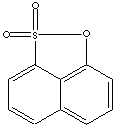PRODUCT IDENTIFICATION

2908.20
CLASSIFICATION
PHYSICAL AND CHEMICAL PROPERTIES
GENERAL DESCRIPTION & APPLICATIONS
Sultone is an internal cyclic monoester (anhydride) derived from the hydroxyl and sulfonic radicals, with the formula -OSO2-.in a ring system. It is an analogous to lactone.

Sultam (a cyclic amide) is the nitrogen analog of sultone. Cyclic sulfur structure and analogues are important nucleuses in pharmacological activity and in printing textile materials. Sultone is used as a chemical intermediate to introduce cyclic sulfo groups into target molecules and to provide water affinity and anionic character.
APPEARANCE
98.0% min
INSOLUBLES
0.1% max (in Chloroform)
SULTONE & SULTAM PRODUCTS
Sultone products
- Bromcresol green [CAS RN: 76-60-8; 641-19-0]: 4,4'-(3H-2,1-Benzoxathiol-3-ylidene)bis(2,6-dibromo-3-methyl)phenol S,S-dioxide , Indicators and reagents
- Naphthosultone [CAS RN: 83-31-8]; Naphthalene-1,8-sultone
- 1,3-Propane sultone [CAS RN: 1120-71-4]: 1,2-Oxathiolane 2,2-dioxide, 3-Hydroxypropanesulfonic acid gamma-sultone
- 2,4-Butanesultone [CAS RN: 1121-03-5]: 3-Methyl-1,2-oxathiolane 2,2-dioxide
- 1,3-Hexadecansultone [CAS RN: 1633-76-7]: 5-tridecyl-1,2-oxathiolane-2,2-dioxide
- 1,4-Butanesultone [CAS RN: 1633-83-6]: 4-Hydroxy-1-butanesulfonic acid delta-sultone
- 1,3-Butanesultone [CAS RN: 3289-23-4]: 3-hydroxy-1-butanesulfonic acid gamma-sultone
- Sulfonefluorescein [CAS RN: 4424-03-7]: O-(3,6,9-trihydroxyxanthen-9-yl)-benzenesulfonic acid gamma-sultone
- 2-Trichloromethyl-1,2-ethanesultone [CAS RN: 6989-70-4]: 4-(trichloromethyl)-1,2-oxathietane-2,2-dioxide
- 2-Hydroxy-alpha-toluenesulfonic acid sultone [CAS RN: 10284-44-3]: 2-hydroxy-benzenemethanesulfonic acid gamma-sultone
- 2-Hydroxy-5-nitro-alpha-toluenesulfonic acid sultone [CAS RN: 14618-10-1]: 5-Nitro-3H-1,2-benzoxathiole 2,2-dioxide
- 1,4-Hexadecansultone [CAS RN: 15224-88-1]: 6-Dodecyl-1,2-Oxathiane-2,2-dioxide
- alpha-Chloro-alpha,2-toluenesultone [CAS RN: 25595-59-9]: alpha-Chloro-alpha-hydroxy-o-toluenesulfonic acid gamma-sultone
- C12-16-alkyl-1,3-sultone [CAS RN: 68609-94-9]
Sultam products
- Thiocyclam [CAS RN: 31895-21-3; 84523-34-2, 31895-22-4 (oxalate salt 1:1)]: N,N-Dimethyl-1,2,3-trithian-5-ylamine; Sultamine; 5-(Dimethylamino)-1,2,3-trithiane; Insecticide
- Sultamicillin [CAS RN: 76497-13-7, 83105-70-8(tosylate)] : Antibacterial, Antibiotic
- (2R)-Bornane-10,2-sultam [CAS RN: 94594-90-8]: (1S)-(-)-2,10-Camphorsultam
- (2S)-Bornane-10,2-sultam [CAS RN: 108448-77-7]: (1R)-(+)-2,10-Camphorsultam